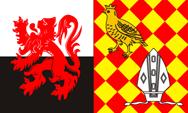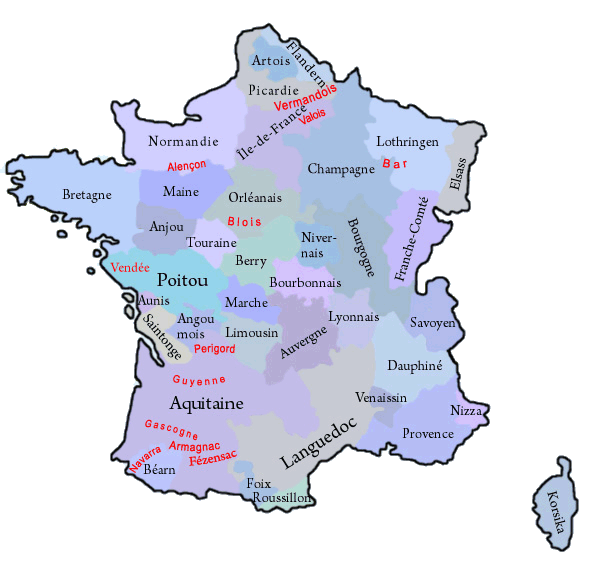mobile View, to the German Version tap the flag


- historical region in France
- former pagus (district) and former province
• Flag
• Meaning/Origin of the Flag
• Coat of Arms
• Meaning/Origin of the Coat of Arms
• Map of the historical Regions in France
• Explanations about the Regions
• History
• Origin of the Country's Name

Flag of Aunis – Drapeau de Aunis,
Source, by:
Wikipedia (DE)




1960–2016,
Unofficial flag of the Region of Poitou-Charentes
– Drapeau de officieux de la Region Poitou-Charentes,
Source, by:
http://svowebmaster.free.fr,
thanks to: Thierry Gilabert




1960–2016,
Unofficial flag of the Region of Poitou-Charentes
– Drapeau de officieux de la Region Poitou-Charentes,
Source, by:
Wikipedia (FR)




The Flag of Aunis shows the image of the coat of arms, a red bunting, topped with a golden, crowned partridge. The in 1960 created Region of "Poitou-Charentes", to which Aunis belonged until 2016, used an unofficial flag. It shows two horizontal stripes in silver and black and a red lion in the middle. The flag is of recent origin, and it is reminiscent of the old coat of arms of Poitou from the time of the Plantagenets (look Poitou). Another model combines the heraldry of the four former provinces, in which Poitou-Charentes consists, Poitou (white-black with red lion), Angoumois (golden-red oblique chessboarded), Aunis (partridge) and Saintonge (Mitra).
Source:
Volker Preuß


Coat of arms of Aunis – Blason du Aunis,
Source, by:
Heraldique Europeenne

The coat of arms of Aunis shows a golden and crowned partridge in red. When the crest was introduced, but also its meaning and origin, are not known. Maybe that the colours go back to Poitou, whose rulers, the Counts of Poitiers, reigned long times over the country.
Source:
Heraldique Europeenne,
Volker Preuß

The historical, French Regions:

in black: governorate and province in 1776,
in red: former county, province oder governorate
Map: Volker Preuß

The until the French Revolution existing provinces (or governorates) have been historically grown structures, which had their roots oftenly in former fiefdoms of the French crown, historic counties and duchies. They oftenly existed for hundreds of years and had preserved regionality (e.g. cultural particularities and regional languages). On the occasion of the French Revolution such phenomena were of course not desirable, and as part of their bloody and violent egalitarianism any regional references were eliminated. Shortly after the French Revolution the provinces were dissolved and France became divided into many départements, which should have approximately the same size and the same status. The départements were named after rivers or mountains, to use never and in no circumstances the name of an old province. However, there was no success in cutting the connections of the people of France to their respective regions, so that administrative regions were re-created in 1960, to have a better control in regional administrative processes. In this way became départements, which were placed in a historical province, administratively grouped to an oftenly historically named region. The resulted structures coincide only approximately with the boundaries of the old provinces. In the strictly centralist France any regionality is avoided, so that even the official flags of these regions mostly look like flags of companies, unloving, unhistorical, technocratic and modernistic, and these flags should not be a subject of any lexical considerations here. Only in a few of that regions, exist official flags which remember the historical models. But, even the existence of these today's regions is douptful, because in 2014 was passed a territorial reform valid from the year 2016, that reduces the number of the existing regions by merging to nearly the half. However, there exist unofficial flags in nearly all of these regions, which should remember the old provinces and the old heraldry.
Wikipedia Link to the regions of France:
click or tap here
FOTW Link to the regions of France:
click or tap here
Source: Flags of the World,
Wikipedia (D),
Volker Preuß

antiquity · colonization by the Celtic tribe of the Santones
52 B.C. · Roman conquest, the area of the today's Aunis comes to the province of Celtica, later to the province of Aquitania
418 A.D. · the Visigoths be settled as federates
5th century A.D. · conquest of Gaul by the Franks (under King Clovis) to 507 conquest of Aquitaine, expansion of the empire to the Atlantic Ocean, the Pyrenees and the Alps
639 · death of King Dagobert I., the power goes over to the Mayors of the Palace (maior domus) of Austrasia (House of the Carolingians)
687 · Pepin II. asserts itself as Mayor of the Palace throughout the Frankish Empire
8th century · fights between the Dukes of Aquitania and the Frankish kings
751 · Pepin the Short (III., grandson of Pepin II.) eliminates the Merovingian monarchy and let hisself elect to the king from the Franks
785 · first mention of Aunis as "pagus alnensis", as a part of Saintonge, within the by the Counts of Poitou ruled territories
843 · division of the Frankish Empire (Treaty of Verdun), there arise the West Frankish Kingdom of Charles II. (the Bald), the Middle Frankish Kingdom of Lothar (Lotharingia), and the East Frankish Kingdom of Louis II., Aquitaine (including Poitou and Saintonge) comes to the Empire of Charles the Bald
870 · at the division of the Frankish Empire (Treaty of Meersen) arises the West Frankish Kingdom, the East Frankish Kingdom, and the Frankish Kingdom of Italy
877 · Ludwig ascends the West Frankish throne, Aquitaine is given as a fief and a duchy to Rainulf, Count of Poitiers, (House of the Ramnulfids)
880 · by the division of the Frankish Empire (Treaties of Verdun and Ribbemont) arises the West Frankish Kingdom (later France), the East Frankish Kingdom (later German Empire), the Kingdom of Italy, the Kingdom of Upper Burgundy (under Rudolf the Welf) and the Kingdom of Lower Burgundy persists
9th/10th century · with the decline of the Carolingian power, and by the disputes of the Counts of Poitou with the Dukes of Aquitaine starts the gradual separation of Aunis from the Saintonge , both are and both remain parts of the County of Poitou
987 · death of the childless West Frankish King Louis V. (House of Carolingians), his heir and uncle Charles of Lower Lorraine could not prevail, the nobility elects Hugh Capet (House of Capet) to the king, the Capetians are the Kings of France to 1328
1130 · Châtelaillon, the capital of Aunis, is conquered in a battle by the Duke of Aquitaine and becomes destroyed, the center of the country is gradually shifting to La Rochelle, which is the new capital from 1151
1152 · Henry Plantagenet marries Duchess Eleanor of Aquitaine, the duchies of Aquitaine and Gascony - and in this way also Aunis - come to the house of Anjou-Plantagenet
1154 · death of Stephen of Blois (King of England) , Henry is his successor as Henry II., Anjou becomes in this way a fief of the French king, which is a part of the crown of England (House of Anjou-Plantagenet)
1204 · Philip Augustus, King of France, conquers Normandy, Anjou, Maine and Touraine (Angevin Empire of the Plantagenets)
1205 · Philip Augustus, King of France, conquers Poitou
1224 · King Louis VIII. of France, son of Philip Augustus, conquers Aquitaine, except Gascony the last possession of the Plantagenets in France, Poitou and Saintonge (incl. Aunis) come directly to the crown, La Marche, Périgord, Angoulême and Auvergne become fiefs
1259 · Treaty of Paris (Abbeville), King Henry III. of England recognizes the loss of Aquitaine, and receives in this way the Saintonge, which is united with Gascony to the Duchy of Guyenne, as fief
1328 · death of King Charles IV. (the Fair), extinction of the direct Capetian line, according to Salic Law Count Philip of Valois (Son of Prince Charles of Valois, first cousin of King Charles IV.) came on the French throne (as King Philip VI .), the English king Edward III. lays claim to the throne as a maternal nephew of Charles IV., reason for the "Hundred Years War" (Anglo-French War, 1338–1453), out of the House of Valois came all kings of France from 1328 to 1589
1356 · Battle of Maupertuis, Poitou is an English possession again
1360 · Treaty of Brétigny, Aquitaine (with Saintonge, Poitou and Aunis) becomes an English possession again and is even released from the feudal dependence of the French kings
1369 · Karl V., King of France, conquers Poitou and hands it over to his brother John, the Duke of Berry
1374 · establish of the provinces of Aunis and Saintonge
1776 · the already in the 14th century created governorates of the civil administration of the kingdom of France become committed to a number of 39, and correspond in this way to the number of provinces, in previous years could any provinces be summarized in one governorate
1789 · French Revolution, the governorates and provinces become abolished, Saintonge and Aunis become merged in the Department of Charente-Inférieure (later Charente-Maritime)
1960 · reintroduction of regions in France, formation of the Region of Poitou-Charentes (capital Poitiers), but not within the historic boundaries, just by integrating of the departments of Charente-Maritime, Charente, Deux-Sèvres and Vienne
2016 · the Poitou-Charentes region merges with the Aquitaine and Limousin regions in the new, larger region of New Aquitaine (Nouvelle-Aquitaine)
Source:
Wikipedia (FR),
Taschenatlas Weltgeschichte

The name "Aunis" goes back to the Latin name of the region as "pagus alnensis", which was first mentioned in the 8th century. Pagus alnensis means "alder country". A Pagus was a district of the Roman administration, and alder is called in Latin "alnus". In the French language it was changed to "pays des aulnes", which was sometimes chortened to "Aunis".
Source:
Wikipedia (FR),
Volker Preuß


![]()












